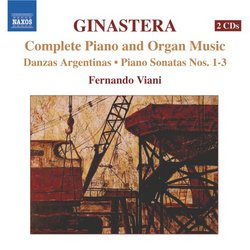COMPLETE
DAVID BRYSON | Glossop Derbyshire England | 07/08/2007
(5 out of 5 stars)
"Ginastera died in 1983, but it seems to have taken until 2006 to record his piano and organ works in their entirety. I say cautiously `seems' because I am still trying to understand what Fernando Viani tells us about the various `children's pieces' here in his liner-note. I read therein `His Argentinian Dances...remained unfinished, with just sketches of a Moderato and a Paisaje. The 1934...Children's Pieces...[remain] unpublished, while the 1942 suite makes direct allusions to Argentine dances...' Disregarding the breathtaking swerve away from the topic in that third case, I don't know what to make of the past tense applied to the Dances. There are a Moderato and a Paisaje here, and they don't sound like just sketches to me, so did Ginastera finish them later, or did someone else finish them, or are they actually incomplete to this day?
One way or another, the Moderato and the Paisaje, together with the Variations and Toccata on Aurora Lucis Rutilat for organ, are receiving their `world premiere recordings' here, and very welcome they are. Ginastera has found a very able, sympathetic and understanding advocate in Fernando Viani, whose approach to the music seems to me more or less ideally judged from beginning to end. Ginastera's piano style has moments of inwardness and delicacy certainly, but for the most part tempi are fast. The fast pieces call for a virtuoso technique certainly, but one of a specialised kind. The focus is strongly on dance-rhythms, and the player has to be a virtuoso with big stomping chords - rapid passage-work, scales, thirds, double trills and the rest of the normal panoply of 19th-century transcendental execution are hardly called for at all. What would kill music like this stone-dead would be any sense of inhibition, and Viani gives it with the sense of abandon that is possible only with as big a technique as he has. This amount of swing and verve in the rhythm comes from absolute assurance with the great fistfuls of notes, and he is able to keep the texture clear and the sound free from any suspicion of ugliness while giving the frequent fortissimo effects in the deep bass all the power and volume they need. The quieter episodes are well done nevertheless, and there is some pleasant filigree work in the `scorrevole' section of the slow movement in the second sonata.
The pieces allegedly for children must have been intended for child prodigies, I'd say, because they are difficult in their own right. Viani quotes the composer's own commentary on the second and third sonatas, but I find that composers tend not to be very enlightening when they talk about their own music. Ginastera's remarks remind me of, say, Alan Rawsthorne's - informative up to a point regarding the influences on the style, but otherwise not telling us much that we can't hear for ourselves. Viani himself in his commentary on the other pieces has a certain amount to say about `synthesising a very personal and a universal message', which is the kind of chatter that means nothing to me. That, together with such concepts as `subjective Americanism' and `American neo-expressionism' may be stylistic features that I shall appreciate better in the fullness of time, but what really strikes me about Ginastera's style is that it didn't seem to change much, whatever he and Viani may say. I like it the way I find it, but it may be some time before I fully appreciate exactly how the second sonata `is without doubt one of the most significant and creative pieces ever written for the piano'. It suits me the way it is, and never mind that sort of hype.
The complete organ works come to a grand total of two. The organ sounds to be quite a big one, but Viani seems perfectly at home with it, and his playing has much the same grandiose characteristics as he displays at the piano. The sound of the instrument has been caught and reproduced without strain and without assaulting the ears, and that gives me my cue to compliment the recording engineers also on the fine job they have done with reproducing the powerful piano effects without a hint either of distortion or of artificial restraint.
And once again my closing refrain - Well done Naxos. I never tire of saying it."

